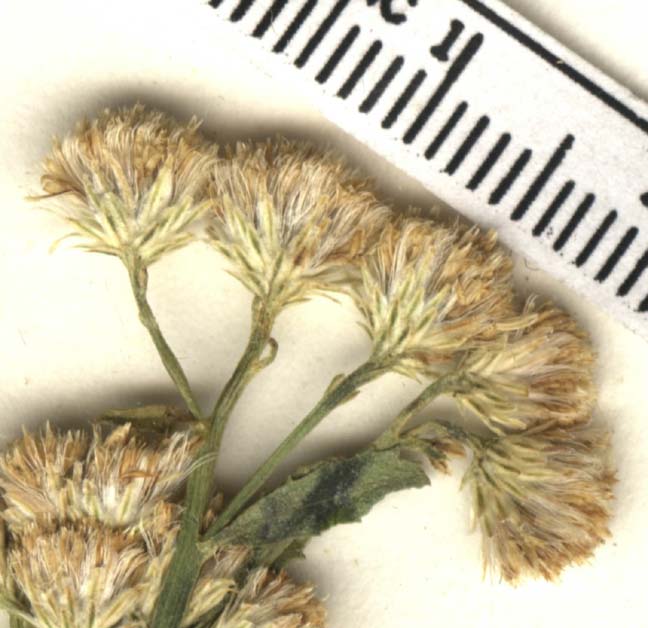
|
Family: Asteraceae |
Perennials, subshrubs, shrubs, or trees, 10-600 cm (dioecious [rarely monoecious], usually glabrous, often resinous; bases woody, rarely rhizomatous). Stems (1-20+) usually erect or ascending, rarely prostrate (usually striate-angled, rarely terete and smooth; usually green), glabrous, glabrate, hispidulous, or villous, often resinous. Leaves cauline (sometimes withering and sparse or absent at flowering); alternate; sessile or petiolate; blades 1- or 3-nerved, linear, lanceolate, ovate, oblong, obovate, or rhombic (usually reduced distally), margins entire or coarsely serrate, faces usually glabrous, rarely hispidulous or villous, often gland-dotted and resinous. Heads (sessile or pedicellate, unisexual) discoid, usually in paniculiform or corymbiform, sometimes racemiform arrays or borne singly. Involucres cylindric to campanulate or hemispheric, 3-9 mm diam. Phyllaries 20-40 in 2-5 series (mid usually green, sometimes red or purple), 1-nerved, ovate to lanceolate, unequal, margins usually scarious, often erose or ciliate, sometimes keeled (midribs evident or not, apices obtuse to acute or acuminate, sometimes keeled), usually glabrous, rarely hispid. Receptacles flat, tholiform, or conic, pitted or smooth (glabrous, tomentose, or glandular), usually epaleate. Functionally staminate florets 10-50 ; corollas white to pale yellow, tubes about equal to narrowly funnelform throats, lobes 5, spreading-reflexed, deltate to lance-ovate (pappi of 20-40 equal, often crisped and minutely barbellate or distally plumose bristles). Pistillate florets 20-150; corollas whitish , filiform-tubular, lobes 5, spreading-reflexed, ± deltate to lance-ovate; style branches (glabrate, flattened), appendages lacking. Cypselae light brown, obovoid to cylindric, ± compressed, 5-10-nerved, glabrous or hispid; pappi persistent or falling, of 25-50 whitish to tawny, rarely brownish (elongating and usually surpassing phyllaries in fruit), minutely barbellate, apically attenuate bristles in 1-3 series. x = 9. Baccharis comprises mostly dioecious shrubs with gland-dotted leaves and is sister to the polygamo-dioecious genera Archibaccharis and Heterothalamus. Sections have been delimited within Baccharis (e.g., D. A. Giuliano 2001; Giuliano and G. L. Nesom 2003; Nesom 1990h, 1998). Species of Baccharis often occur in wet sites such as stream banks, washes, ditches, and marshes. Useful taxonomic characters include habit, branching structure, leaf shape, size, margins, and vestiture, arrangement of heads, and number of nerves on cypselae. Collectors should try to collect both staminate and pistillate individuals to facilitate identification. Hybridization and introgression have been found between Baccharis halimifolia and B. neglecta, and between B. halimifolia and B. angustifolia. Intermediates between B. thesioides and B. bigelovii have been collected in southern Arizona. Baccharis is of little economic importance, except for species that are invasive or toxic to livestock (P. E. Boldt 1989). Baccharis is not generally palatable to cattle; it could become the only forage available as a result of overgrazing. In the southwestern United States, B. pteronioides is a hazard to cattle; B. halimifolia, B. angustifolia, and B. glomeruliflora cause similar problems in the eastern United States (G. E. Burrows and R. J. Tyrl 2001). Baccharis pilularis invades overgrazed or eroded rangelands in California and Oregon. Baccharis halimifolia has been introduced in Australia, infesting large areas along the eastern coast, prompting the search for biological control agents (Boldt). Neomolina F. H. Hellwig is an illegitimate, later homonym that has been applied to species included here in Baccharis. In key leads, references to pappi are to pappi on cypselae (i.e., in pistillate heads).
Dioecious; fertile heads with ±numerous tubular-filiform pistillate fls; sterile heads with ±numerous seemingly perfect but functionally staminate fls, the ovary abortive, the style-branches sometimes connate; fls white to yellowish or greenish; receptacle flat or merely convex, naked; invol bracts subequal to strongly imbricate, chartaceous or subherbaceous; pappus of numerous capillary bristles, those of the sterile heads fewer and shorter than those of the fertile ones; achenes usually somewhat compressed and ribbed; shrubs or subshrubs with alternate lvs. 400, New World, mainly trop. and warm-temp. Gleason, Henry A. & Cronquist, Arthur J. 1991. Manual of vascular plants of northeastern United States and adjacent Canada. lxxv + 910 pp. ©The New York Botanical Garden. All rights reserved. Used by permission. |



